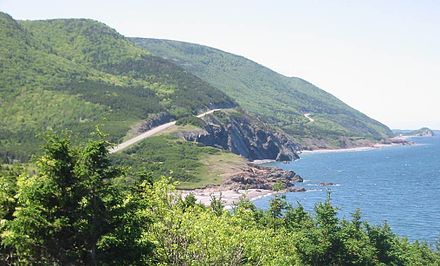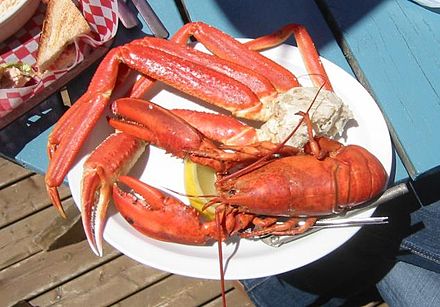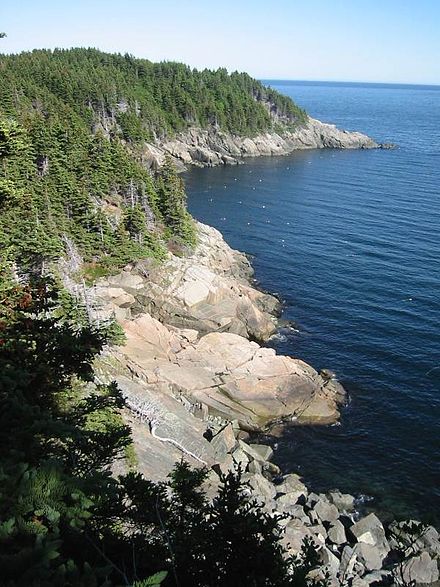 Cape Breton Island is the northernmost island in Nova Scotia. It is a beautifully rugged island, populated by the descendants of Scottish immigrants, by Acadians, and by the Indigenous Mi'kmaq people. The island is known for its traditional fiddle music, and flourishing Celtic culture.
Cape Breton Island is the northernmost island in Nova Scotia. It is a beautifully rugged island, populated by the descendants of Scottish immigrants, by Acadians, and by the Indigenous Mi'kmaq people. The island is known for its traditional fiddle music, and flourishing Celtic culture.
Cities and towns
- Sydney — largest city on the island
- Glace Bay — the second largest urban area and situated on the east side of the island
- North Sydney — end of the Trans-Canada Highway with ferry connections to Newfoundland
- New Waterford — former mining town
- Sydney Mines — a former coal mining town
- Port Hastings — east end of the Canso Causeway
- Port Hawkesbury — a town on the southwestern end of the island
- Baddeck — summer resort area and convenient starting/finishing point for the Cabot Trail
- Chéticamp — centre of Acadian culture on the Cabot Trail
- Louisbourg — one-time French colonial town best known for its reconstructed fortress
- Ingonish — on the Cabot Trail and adjacent to the Cape Breton Highlands National Park
- Arichat — a village of Acadian culture on Isle Madame
- Mabou — fishing and farming community on the west side of the island
- St. Peter's — a small village and the "Gateway to the Bras d'Or"
- Eskasoni 📍 — (Eskasoni First Nation) the largest Mi'kmaq community in Nova Scotia
Other destinations
- Cape Breton Highlands National Park – Atlantic Canada's first national park
Understand
Cape Breton Island was a separate colony until 1820 when it was merged into Nova Scotia against its will. It is the only place in North America where Gaelic is still spoken, a legacy of the large immigration (about 50,000) from the highlands of Scotland in the first half of the 19th century. There are also pockets of French, remnants of the Acadian history described in the Longfellow epic poem "Evangeline", in towns such as Margaree and Chéticamp and on Isle Madame.
With 5 Mi'kmaq communities in Cape Breton (4 are around the Bras d'Or Lake) there is a strong island identity and sense of community, which increasingly unifies the Mi'kmaq population of the island.
The island has consistently lost industrial investment and jobs in the past ten years. However, the closing of the coal and steel industry coupled with the presence of the Cape Breton Highlands National Park, which buffers the pristine northern half of the island from its more commercialized southern half, have no doubt contributed to the island's very positive ratings for ecological stewardship and spectacular scenery. An excellent reference site for the incredibly beautiful northern tip of Cape Breton can be found at the "Top of the Island" site.
Get in
By car
The most common way to get into Cape Breton is by car via the Trans-Canada Highway (Hwy 104) at the Canso Causeway from mainland Nova Scotia. Cape Breton is approximately 12½ driving hours from Boston, 14 from Hartford and 16 from New York City.
By bus
Maritime Bus runs between Truro and Sydney with onward connections to much of New Brunswick and Nova Scotia.
Shuttle service is provided between Halifax and Sydney and environs by several companies who travel at various times throughout the day. Excellent value.
By plane
Cape Breton Island is served by Sydney Airport.
Get around
Cape Breton is most accessible by car. The main road is the Trans-Canada highway (Hwy 105), which connects Sydney on the east coast with the causeway to the mainland on the west. You can rent a car in Sydney if necessary. Like any place, you see more if you get off the main road, and the Nova Scotia government has been helpful in this regard by creating a number of scenic drives. These include the:
- Cabot Trail - Mountainous, windy and sometimes foggy, this drive alternates between hugging the ocean and crossing the rugged Cape Breton Highlands. Considered one of the top drives in North America, it should be considered more a destination than a drive for the variety of activities available around this 400-km (190-mile) loop.
- Fleur-de-Lis Trail - covers the southern French-influenced part of the island.
- Ceilidh Trail - covers the western part the island with its strong Scottish influence.
- Bras d'Or Lake Scenic Drive - follows the shoreline of Bras d'Or Lake.
Road maps and additional information on the island is readily available at any tourism information center (located at entry points and any major towns and cities) and a number of private operators offer trip planning services.
 A more adventurous option to get around the island is to cycle. The roads tend to be narrow and windy, so prior experience is recommended. Bike rental and trip planning are available through Sea Spray Outdoor Adventures.
A more adventurous option to get around the island is to cycle. The roads tend to be narrow and windy, so prior experience is recommended. Bike rental and trip planning are available through Sea Spray Outdoor Adventures.
Hiking trails abound in Cape Breton Highlands National Park, and the above-mentioned Sea Spray Outdoor Adventures offers guided hikes to little-known remote areas north of the national park.
Regardless of your mode of travel, watch out for moose on the roads.
There are many small cable ferries between the islands. They usually go every few minutes and charge $5.
Salty Bear Adventure Travel - an excellent alternative to renting a car, Salty Bear offers budget adventure tours around the Cabot Trail. Run by passionate travellers who aim to provide a true Cape Breton experience, their trips include roundtrip transportation, accommodation, guide with full commentary, guided hikes, National & Provincial Park access, ferry passes, wildlife encounters, barbecues, bonfires. Discounted optional activities of kayaking, sailing, and whale watching.
See

Cape Breton is noted for its unique and vibrant traditional Scottish violin music incubated by its relative isolation over the years- so much so that music lovers from Scotland come here for a taste of their own past. Typically a duo of violin and piano play hearty dance music that can be seen at community halls throughout the island. The early-evening tourist-targeted concerts are well advertised; later at night you can find ones that draw the entire local community. Some of the most important musical centres are Judique, Margaree Valley and Chéticamp.
The island ranked second in the world in a National Geographic study of ecotourism conducted in 2002 and 2003.
Cape Breton Highlands National Park. The Cabot Trail runs through the national park. There are many short hiking trails starting along the Cabot Trail.
Scenery is a major reason to visit Cape Breton. Plan to stop along the many spectacular lookoffs on the Cabot Trail - this will lengthen your travel time between destinations. Since the Cabot Trail is more a destination than a drive, visitors seeking to truly experience this environmental masterpiece should plan on staying a minimum of two days in the villages around the Trail. A number of private operators offer trip planning services to assist visitors in taking advantage of the best attractions both on and off the Trail, some offering all-inclusive multi-day packages.
The Fortress of Louisbourg is a reconstruction of the 18th-century fortified French town whose presence plagued the British colonies of New England. Its busy harbour was once one of France's most significant economic and military assets in North America. If you enjoy the colonial restoration at Williamsburg in the United States, don't miss Louisbourg.
The Bras D'Or is a brackish lake with unique ecological characteristics, and some islands in that lake are sacred to the Mi'kmaq.

Bay St. Lawrence and Meat Cove are two scenic fishing villages featuring whale tours, fresh seafood and unique accommodations along the rugged cliffs north of the Cabot Trail. Turn north at Cape North.
 Joe's Scarecrows at Cheticamp on the Cabot Trail. Scary gallery of scarecrows with Halloween masks. Entrance is free, but they ask for a small donation.
Joe's Scarecrows at Cheticamp on the Cabot Trail. Scary gallery of scarecrows with Halloween masks. Entrance is free, but they ask for a small donation.
Les Trois Pignons in Cheticamp is a museum of Acadian culture based on collection of antiques.
The Alexander Graham Bell National Historic Site in Baddeck has exhibits, photos and videos relating to the life and work of the inventor of the telephone.
The Cape Breton Miners Museum in Glace Bay has an underground mine tour, abd a mining history museum with modern exhibits. Stroll through a historic village. "Men of the Deeps" miners' choir offers performances (several times per season.
Do
There are eight golf courses scattered about the island that will challenge even the most discriminating among you. The views planes alone are worth the walk: coastal links, highland links, and several of the Bras d'Or Lakes.
The east side of the island have some of finest beaches in the world but without the crowds. Hiking or lounging are the favourite activities as the water is never very warm. You'll see sea birds, shore birds, seals and surf with nothing between you and Africa but water.
The Celtic Colours Festival spans hundreds of events across dozens of towns in early-to-mid-October. The music options at Celtic Colours are not solely Celtic but include folk and some Acadian Zydeco (Acadeco) and jazz, and world music.
Take a whale watching tour: there are boat tours along the coast from Cheticamp north and around to Englishtown. Sighting of whales is almost guaranteed, especially at the northern tip of the island. Tours takes two hours or more, and the scenery alone is worth the price. Oshan Whale Cruises and Captain Cox's Whale Tour operate at the northern tip of the island.
Many people think that biking the Cabot Trail is the best way to see it. Featured in an issue of Bicycling magazine, as "North America's Best Ride". Pedal and Sea Adventures can arrange a tour.
There is lots of self-guided hiking in the Cape Breton Highlands National Park.
Eagle North and Sea Spray both offer guided kayak tours, in the large tranquil harbours at the top of the island and in the whale-rich Atlantic.
The Top of the Island, north and northeast of Cape Breton Highlands National Park, is the most spectacularly scenic region of Cape Breton. It offers a combination of historic, cultural and environmental activities, featuring whale watching, guided hiking, cycling, and paddling tours, museums, artists' studios and galleries and seven miles of the most significant beaches north of the Carolinas. The region is home to Cabot's Landing Provincial Park, the site of John Cabot's landing in 1497.
Buy
Many of the smaller communities have only a general store that sells a very limited selection of groceries and sundries, often also operating as a local post office. Better to stop in a bigger centre like Baddeck or Cheticamp for groceries, although the Top of the Island area has two Co-op grocery stores (somewhat smaller than the Co-ops in Baddeck and Cheticamp) and a couple of independents that, taken together, do a reasonable job.

The Wreck Cove General Store (pictured) is open year-round and sells things a traveller might need, from fuel to weather-appropriate clothing to snacks. Their "World Famous Lobster Sandwich" is highly recommended and can be bought during the summer season. Located on the Cabot Trail between Baddeck and Ingonish.
- Floras, Point Cross, +1 902 224-3139. Handcrafts. Especially traditional Acadian rug-hooking made by locals. Demonstrations.
- Local pottery and other juried Cape Breton Only crafts. Sold along the Cabot Trail at Arts North, outside Cape North, at the northern tip of the Trail.
- St. Ann's Artisans St. Ann's, an area to the south of Ingonish along the Cabot Trail, has a large concentration of artisans who work and sell out of their shops. Leather, glass, woodworking, iron art, photography, pottery, pewter and sewing are all found, made by skilled artists, within an hour's drive north of Baddeck.
Smelt Brook Pottery Studio at the Top of the Island in Smelt Brook features two production potters. The studio is open to the public and is a popular rainy-day stop for family learning experiences.
- Nest (Patti Millet-owner), 11352 Route 19, Mabou, +1 902 945-2414. 10AM-6PM. Nature themed shop featuring jewellery, gifts and home décor. Emphasis on artisan crafts. Local music CDs. All price points, kids welcome, washroom always available.
- Glenora Distillery, 13727 Route 19, Glenville, +1 902-258-2662. Glen Breton Rare single malt whisky. Guided tours are run hourly every day, 9AM-5PM from May-October ($7/person). 2015-07-16
- Arts North:, Cabot Trail at Cape North (drive to the northern tip of the Cabot Trail, Arts North is 3 km SW of Cape North Village), +1 902 383-2911. 9AM-7PM. A retail gallery featuring the works of over two dozen juried Cape Breton resident artisans. Pottery, jewellery, weaving, quilts, wood, prints, basketry, canvas and other media are all displayed in an architecturally pleasing space. The gallery ships purchases worldwide for its customers.
Eat

Seafood, especially lobster, is the thing to eat on Cape Breton. The Aspy Bay oysters are also good. As mentioned in the "Buy" section, if you plan to save money by getting groceries, do so at larger centres such as Chéticamp and Baddeck. Small convenience stores tend to be more sparsely stocked than convenience stores you would find in cities.
- Rusty Anchor, Pleasant Bay, +1 902 224-1313. Great seafood, fantastic seaside patio. If you are lucky you can spot a bald eagle hovering above you. Sandwiches $10, special seafood plates $20.
- Cedar House, TCH 105m Boulebarderie Centre, at the Seal Island bridge between Baddock and Sydney, +1 902 674-2929. May-Oct 10AM-8PM. Bakery and restaurant. Good seafood chowder at reasonable prices.
Try out pizza burgers. Like a regular burger with bun, but replace the meat patty with pepperoni, mozzarella cheese and tomato paste sauce. You can buy them in convenience stores and gas stations. They come refrigerated. To consume them, poke a hole in the packaging and put it in microwave for 30 seconds. Let it rest for a minute before consumption.
Drink
Sleep

A good number of Bed & Breakfasts and hostels are dotted throughout the island. A few examples follow:
- Chambers Guest House B&B. Experience gracious hospitality in an atmosphere of a 1880 Victorian home filled with antiques and art-works. Situated in the centre of North Sydney and only minutes from the ferry to Newfoundland.
- Wreck Cove Wilderness Cabins +1 902 929-2800 Open year round, these cosy cabins are tucked into the forests of the Cabot Trail. Only a few hundred metres from the wild Atlantic cliffs, a perfect getaway. Located between the two top golf courses "Baddeck Bay" and "Highland Links" in Ingonish.
- Two Tittle Inn B&B, White Point
- Oakwood Manor B&B, Cape North
- Seymour Harbour B&B, Neils Harbour
- Keltic Lodge, Middle Head Peninsula, Ingonish Beach. This resort and spa is on the spectacular Middle Head peninsula. There are views of the sea to both sides. Just behind the main lodge is the start of the hiking trail to the tip of Middle Head. Double room $190 in high season, $290 including gourmet dinner and breakfast for two. The dresscode is casual smart.
- Glenora Inn & Distillery, Route 19, Ceilidh Trail, Glenville, info@glenora1.ca. Sleep at North America's only single malt distillery. Has restaurant and bar. Rooms from $120
- Silver Dart Lodge, 257 Shore Rd, Baddeck, +1 902 295-2340, sdladmin@maritimeinns.com. Open May-Oct. Rooms from $99-119
- Cabot Trail Hostel, Pleasant Bay, +1 902 224-1976, hostel@cabottrail.com. Bed $27/night, private room $59/night (extra person $10/night), All prices tax included. Clean establishment, friendly owners!
- Castle Rock Country Inn, 39339 Cabot Trail, Ingonish, castlerock@ns.sympatico.ca. Spacious, comfortable, non-smoking rooms with satellite TVs and queen-sized beds. Small licensed dining room and lounge with excellent food and Nova Scotian wines. Large patio in back has beautiful views of the bay - eagles and other wildlife can often be seen. Friendly hosts and cute-yet-inconspicuous pets. $89-148. (Packages also available.)
- Bear on the Lake Guest House // HI Cape Breton Island, 10705 HWY 105, Aberdeen (Between Whycocomagh and Baddeck), +1 902 756-2750, info@bearonthelake.com. Dorm rooms $25-30. Private rooms with private lounge $65-75. Features include: 10 minutes from the start of the Cabot Trail. Overlooking the Bras D'Or Lakes, patio, BBQ, firepit, free internet/ WiFi, linens, laundry facilities, tours of the Cabot Trail can be arranged.
- The Water's Edge Inn, 22 Water Street, Baddeck, +1 902-295-3600. Spacious king, queen rooms with private baths. Balconies overlooking the lighthouse and the beautiful Bras d'Or lakes. Breakfast.
- Big Hill Retreat, Big Hill Road, Baddeck, +1 902 295-2726. Lovely secluded cottages on a peaceful wilderness homestead with gardens, pond and pottery studio. $90-130/night
- Bras d'Or Lakes Inn (Bras d'Or Lake Scenic Route), 10095 Grenville Street (Hwy 104 towards Sydney). Check-in: 2PM, check-out: 11AM. Waterfront 4-star well-kept inn with 5-star licensed restaurant and lounge. 20 rooms in cedar lodge right beside the St. Peter's Canal. All rooms have private bath, internet access, flat screen cable television, fridge, microwave and coffee machine. Waterfront activities available. Rooms from $110
Stay safe
In Cape Breton Highlands National Park, there are bears and coyotes that could be dangerous. Instructions are given on signs at the entrance of hiking trails, teaching how to proceed when encountering these species that may feel threatened by you. Respect those instructions for your own good.
Crime is almost non-existent and the weather can be a factor of danger especially in the winter due to its tendency of quickly changing.
Go next
If you want to do a bit of island-hopping Atlantic Canada-style, you can take one of two ferries from North Sydney to Newfoundland. The ferry to Port aux Basques on Newfoundland's south-west coast is the shorter of two and runs daily throughout the year. The ferry to Argentia is much longer (about 14 hours) and only runs in the summer, three times a week. Ferry services are provided by Marine Atlantic.